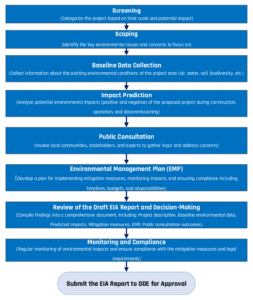
What is Environmental and Social Impact Assessment? ESIA Definition & Meaning
An Environmental and Social Impact Assessment (ESIA) is a process used to evaluate the potential environmental and social impacts of a proposed project or development. It provides a systematic analysis of the effects a project may have on the environment and the surrounding community. The goal is to anticipate any negative impacts and propose ways to avoid, mitigate, or manage them to ensure sustainable development.
The EIA process is widely recognized and used in project planning, particularly for large-scale developments such as infrastructure projects, industrial developments, mining, oil exploration, and other activities that could have significant environmental and social consequences.
Key Components of EIA by Kingsley
Environmental Impact Assessment (EIA): This part of the process focuses on identifying, predicting, evaluating, and mitigating the adverse effects that a project might have on the natural environment, such as air quality, water resources, biodiversity, soil, and ecosystems. The EIA typically includes:
-
- Baseline data collection: Understanding the current state of the environment before the project begins.
- Impact prediction: Assessing how different project activities might affect the environment.
- Mitigation strategies: Proposing measures to reduce or offset negative environmental impacts.
- Changes to local livelihoods, employment, and economic activities.
- Impacts on health, safety, and well-being of local populations.
- Effects on culture, social structures, and human rights (e.g., displacement, changes in land use, or cultural disruption).
- Public consultations to gather input from affected stakeholders.
Steps to Conducting an EIA
1. Screening: The first step involves determining whether a proposed project requires an EIA and to what extent it should be conducted. Some small-scale or low-impact projects may be exempt from detailed assessments.
2. Scoping: This stage defines the scope of the assessment, identifying the key environmental and social issues that need to be considered. It also outlines the methodology to be used for data collection and impact analysis.
3. Baseline Studies: Data is collected to establish a baseline condition of the environment and the social context before the project starts. This includes environmental factors (e.g., air quality, water bodies, wildlife) and social factors (e.g., local demographics, employment patterns, infrastructure).
4. Impact Assessment: The potential environmental and social impacts of the project are predicted and analyzed. This step includes identifying direct, indirect, cumulative, and residual impacts, as well as their severity, duration, and significance.
5. Mitigation and Management: Based on the identified impacts, strategies are developed to avoid, reduce, or offset negative effects. This may involve redesigning aspects of the project or implementing corrective measures to address anticipated problems.
6. Public Consultation: The EIA process typically involves engaging with the public and stakeholders, especially local communities who may be directly impacted by the project. Public hearings, consultations, and feedback mechanisms are used to ensure that concerns and suggestions are considered.
7. Reporting: The findings of the EIA are compiled into a comprehensive report, which presents the results of the assessment, proposed mitigation measures, and the overall environmental and social management plan. This report is submitted to regulatory authorities for review and approval.
8. Decision-making: Based on the EIA report, the relevant authorities decide whether the project can proceed, and if so, under what conditions. If significant negative impacts are identified, they may require modifications to the project, or it may be rejected altogether.
9. Monitoring and Follow-up: Once the project is approved and underway, ongoing monitoring ensures that the mitigation measures are effectively implemented and that the project’s actual impacts are consistent with the predictions. Any unforeseen issues can be addressed in this phase.
Process Flow Chart of Environmental Impact Assessment
Benefits of EIA
- Preventing Negative Impacts: By identifying potential environmental and social issues before the project begins, an ESIA can help prevent irreversible damage.
- Informed Decision-making: Governments and project proponents can make better decisions based on a thorough understanding of the potential impacts and risks.
- Sustainable Development: Ensures that economic development occurs in a way that protects both the environment and the well-being of affected communities.
- Community Engagement: It fosters transparency and provides a platform for stakeholders, especially local communities, to voice their concerns, leading to better project outcomes.
- Compliance with Regulations: Helps projects comply with national and international environmental and social standards, avoiding legal and reputational risks.
Examples of EIA Applications
- Industrial Sector: In the industrial sector, ESIA applications play a crucial role in ensuring that projects are developed in a sustainable and responsible manner.
- Textile Industries: ESIA in the textile industry helps manufacturers and stakeholders balance profitability with sustainability. By addressing environmental and social impacts in the planning, production, and distribution processes, ESIA promotes the long-term viability of the industry while minimizing harm to the planet and communities. As the demand for sustainable and ethical products continues to rise, ESIA will be increasingly essential for companies aiming to stay competitive and responsible in the global marketplace.
- Infrastructure Projects: Building a new highway through a forest could require an ESIA to assess the impact on wildlife, local communities, and air quality.
- Oil & Gas Exploration: Drilling in sensitive areas like the Arctic or a tropical rainforest would trigger a detailed assessment of environmental and social risks, including habitat destruction, pollution, and effects on indigenous populations.
- Mining: A proposed mining operation in a region rich in biodiversity and local communities might require an ESIA to analyze potential water contamination, soil degradation, and displacement of local populations.
- Urban Development: Large-scale urban expansion in a region with fragile ecosystems or vulnerable populations would need an ESIA to evaluate the impacts on local ecosystems, land use, and human health.
Challenges in EIA
- Complexity: Assessing environmental and social impacts can be complex, requiring multidisciplinary expertise and access to large amounts of data.
- Uncertainty: Predicting all the potential impacts of a project, especially for long-term and large-scale developments, can be challenging.
- Stakeholder Disagreement: Diverse stakeholders may have conflicting interests, making consensus-building difficult, especially in projects that affect local communities.
- Implementation and Monitoring: Even if an ESIA identifies potential impacts and suggests mitigation strategies, ensuring that these measures are implemented and monitored throughout the project lifecycle can be challenging.
So, an Environmental and Social Impact Assessment is a critical tool for ensuring that development projects are conducted responsibly, balancing economic growth with environmental conservation and social well-being. Through comprehensive analysis and stakeholder engagement, ESIA helps promote sustainability and minimizes harmful consequences for both the environment and local communities.

Environmental and Social Impact Assessment (ESIA) of the Textile Industry in Bangladesh
Environmental and Social Impact Assessment (ESIA) is a crucial tool for ensuring sustainable development, especially in sectors like the textile industry, which often have significant environmental and social impacts. In Bangladesh, one of the largest textile manufacturing countries globally, the need for ESIA in the textile sector has grown due to increasing concerns over environmental degradation, labor rights, and community well-being.
1. Environmental Impacts of the Textile Industry in Bangladesh
Textile manufacturing, especially in countries like Bangladesh, can have profound environmental impacts:
- Water Pollution: The dyeing and finishing processes use large quantities of water and chemicals, leading to the contamination of water bodies with toxic substances. Many textile mills discharge untreated wastewater into rivers and canals, which adversely affects local ecosystems and the livelihoods of communities dependent on water resources.
- Air Pollution: Textile factories may emit hazardous air pollutants from processes like dyeing, finishing, and bleaching. Emissions from industrial boilers, furnaces, and diesel generators also contribute to air quality degradation.
- Solid Waste: The industry generates a significant amount of waste, including textile scraps, chemical sludge, and packaging waste. Improper disposal of these wastes can lead to land contamination.
- Energy Use: The textile industry is energy-intensive, with significant carbon emissions associated with electricity consumption, especially if fossil fuels are the primary energy source.
- Chemical Use: The use of chemicals in dyeing and finishing processes (such as azo dyes, solvents, and other toxic chemicals) poses risks to both environmental and human health.
2. Social Impacts in the Textile Industry
Social concerns in Bangladesh’s textile industry are significant, primarily because it is one of the largest sectors of the economy, employing millions of workers, many of whom are women.
- Labor Rights and Working Conditions: Labor rights violations are a major concern in the textile industry. Poor working conditions, inadequate safety measures, low wages, and long working hours are common in many factories. Workers are often exposed to hazardous chemicals and unsafe machinery, leading to health risks such as respiratory issues, skin diseases, and injuries.
- Child Labor: Despite legal prohibitions, child labor remains an issue in certain parts of the textile and garment sector, though the situation has improved over time due to stricter enforcement and advocacy.
- Health and Safety: Occupational health and safety in Bangladesh’s textile industry are key concerns. The 2013 Rana Plaza disaster, in which over 1,000 workers died due to a building collapse, highlighted the critical need for better safety standards and regulatory enforcement.
- Community Impact: The development of textile factories can have both positive and negative impacts on local communities. While they provide jobs and contribute to the local economy, poor waste management practices, inadequate infrastructure, and pollution can harm public health and degrade living conditions.
3. Regulatory Framework for ESIA in Bangladesh’s Textile Sector
The regulatory environment in Bangladesh requires certain industries, including textiles, to conduct Environmental Impact Assessments (EIA) for new projects. The Ministry of Environment, Forest and Climate Change (MOEFCC) oversees environmental regulations, including the approval of industrial projects.
- Environmental Protection Act 1995: This law lays the foundation for environmental protection in Bangladesh. It requires industries to follow prescribed environmental standards and obtain environmental clearance before commencing operations.
- Environmental Conservation Rules 1997 & 2023: These rules outline the procedures for conducting an Environmental Impact Assessment (EIA), including for textile industries. The EIA report must identify environmental impacts and propose mitigation measures.
- The Bangladesh Labor Act, 2006: This Act sets the legal framework for labor standards, including working hours, wages, and safety conditions in the textile industry.
- The Bangladesh Accord on Fire and Building Safety (2013): In response to the Rana Plaza disaster, this legally binding agreement between retailers, trade unions, and NGOs was signed to ensure better safety standards in Bangladesh’s garment factories.
4. The Role of ESIA in Promoting Sustainable Textile Manufacturing
ESIA plays a key role in ensuring that textile manufacturing in Bangladesh is environmentally and socially sustainable. An ESIA typically involves:
- Environmental Impact Assessment: Identifying potential environmental impacts and proposing measures to mitigate negative effects, such as wastewater treatment plants, pollution control technologies, and sustainable resource management practices.
- Social Impact Assessment: Assessing the impact of the project on local communities, workers, and stakeholders. This involves evaluating labor conditions, community health risks, and providing suggestions for improving worker welfare, health, and safety.
- Public Participation: ESIA processes often involve consultations with local communities and stakeholders to ensure their concerns are addressed, and their input is considered in the decision-making process.
5. Challenges in Implementing ESIA in Bangladesh's Textile Sector
While there is a regulatory framework in place, the effective implementation of ESIA in Bangladesh’s textile industry faces several challenges:
- Weak Enforcement: Despite the existence of laws, enforcement remains weak in many areas. Many factories do not comply with environmental standards, and labor laws are often violated without sufficient penalties.
- Limited Awareness: Many small and medium-sized textile factories lack awareness about environmental and social standards and may not prioritize conducting an ESIA or implementing mitigation measures.
- Cost Implications: Conducting a thorough ESIA can be costly and time-consuming, particularly for smaller factories with limited resources.
- Lack of Expertise: There is a shortage of trained professionals capable of conducting comprehensive ESIAs in the textile sector. Many firms rely on external consultants, but their reports may not always be of high quality.
6. Recent Trends and Innovations
In recent years, there has been growing interest in sustainable practices in the Bangladesh textile industry:
- Green Certification Programs: Several factories are now pursuing certifications like LEED (Leadership in Energy and Environmental Design) or ISO 14001 (Environmental Management Systems) to demonstrate their commitment to sustainability.
- Wastewater Treatment Technology: Some textile mills are investing in more advanced wastewater treatment technologies to reduce water pollution.
- Sustainable Fabrics and Dyeing: There is an increasing trend toward using organic and sustainable materials, as well as adopting waterless dyeing and other eco-friendly technologies.
- Circular Economy Initiatives: Some textile companies are exploring recycling and upcycling practices to minimize waste and extend the life cycle of textiles.
Technical Assistance
Please use our technical support form or call our EIA professionals at +8801714063383 or mail at [email protected] if you need technical help with any of the issues brought up.

You must be logged in to post a comment.